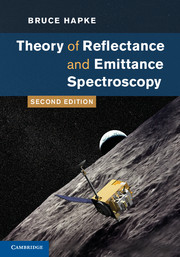Book contents
- Frontmatter
- Contents
- Acknowledgments
- 1 Introduction
- 2 Electromagnetic wave propagation
- 3 The absorption of light
- 4 Specular reflection
- 5 Single-particle scattering: perfect spheres
- 6 Single-particle scattering: irregular particles
- 7 Propagation in a nonuniform medium: the equation of radiative transfer
- 8 The bidirectional reflectance of a semi-infinite medium
- 9 The opposition effect
- 10 A miscellany of bidirectional reflectances and related quantities
- 11 Integrated reflectances and planetary photometry
- 12 Photometric effects of large-scale roughness
- 13 Polarization of light scattered by a particulate medium
- 14 Reflectance spectroscopy
- 15 Thermal emission and emittance spectroscopy
- 16 Simultaneous transport of energy by radiation and thermal conduction
- Appendix A A brief review of vector calculus
- Appendix B Functions of a complex variable
- Appendix C The wave equation in spherical coordinates
- Appendix D Fraunhofer diffraction by a circular hole
- Appendix E Table of symbols
- Bibliography
- Index
7 - Propagation in a nonuniform medium: the equation of radiative transfer
Published online by Cambridge University Press: 05 January 2012
- Frontmatter
- Contents
- Acknowledgments
- 1 Introduction
- 2 Electromagnetic wave propagation
- 3 The absorption of light
- 4 Specular reflection
- 5 Single-particle scattering: perfect spheres
- 6 Single-particle scattering: irregular particles
- 7 Propagation in a nonuniform medium: the equation of radiative transfer
- 8 The bidirectional reflectance of a semi-infinite medium
- 9 The opposition effect
- 10 A miscellany of bidirectional reflectances and related quantities
- 11 Integrated reflectances and planetary photometry
- 12 Photometric effects of large-scale roughness
- 13 Polarization of light scattered by a particulate medium
- 14 Reflectance spectroscopy
- 15 Thermal emission and emittance spectroscopy
- 16 Simultaneous transport of energy by radiation and thermal conduction
- Appendix A A brief review of vector calculus
- Appendix B Functions of a complex variable
- Appendix C The wave equation in spherical coordinates
- Appendix D Fraunhofer diffraction by a circular hole
- Appendix E Table of symbols
- Bibliography
- Index
Summary
Introduction
Virtually every natural and artificial material encountered in our environment is optically nonuniform on scales appreciably larger than molecular. The atmosphere is a mixture of several gases, submicroscopic aerosol particles of varying composition, and larger cloud particles. Sands and soils typically consist of many different kinds and sizes of mineral particles separated by air, water, or vacuum. Living things are made of cells, which themselves are internally inhomogeneous and are organized into larger structures, such as leaves, skin, or hair. Paint consists of white scatterers, typically TiO2 particles, held together by a binder containing the dye that gives the material its color. These examples show that if we wish to interpret the electromagnetic radiation that reaches us from our surroundings quantitatively, it is necessary to consider the propagation of light through nonuniform media.
Although the equations for this problem can be formally written down (Ishimaru, 1978), their solution to produce useful, practical answers is another matter. The exact solution of Maxwell's equations for this class of problems is possible today only for ensembles of a small number of particles of relatively simple shapes, even with the help of modern high-speed computers. Several persons have obtained direct solutions of Maxwell's equations for a few interacting spheres (e.g., Liang and Lo, 1967; Bruning and Lo, 1971a, b; Fuller and Kattawar, 1988a, b; Xu, 1995). Lumme et al (1997) used the discrete dipole approximation to synthesize scattering by several particles.
- Type
- Chapter
- Information
- Theory of Reflectance and Emittance Spectroscopy , pp. 145 - 179Publisher: Cambridge University PressPrint publication year: 2012



